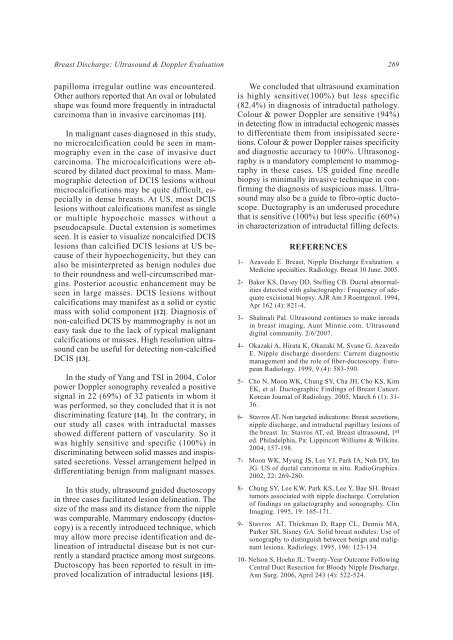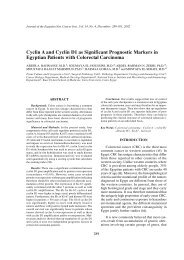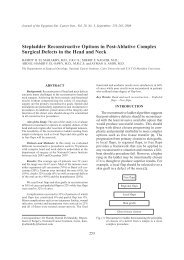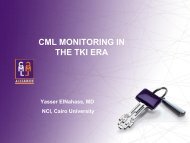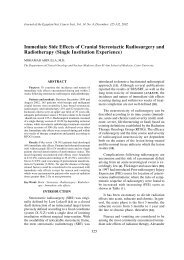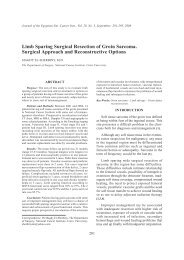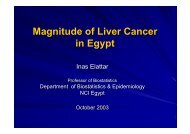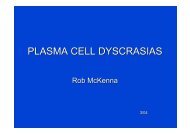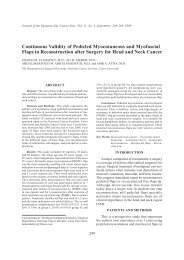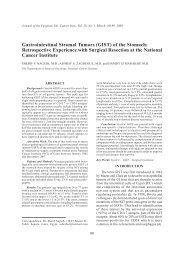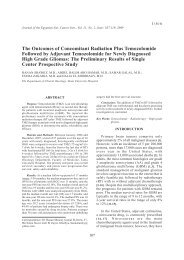Breast Discharge: Ultrasound and Doppler Evaluation - NCI
Breast Discharge: Ultrasound and Doppler Evaluation - NCI
Breast Discharge: Ultrasound and Doppler Evaluation - NCI
You also want an ePaper? Increase the reach of your titles
YUMPU automatically turns print PDFs into web optimized ePapers that Google loves.
<strong>Breast</strong> <strong>Discharge</strong>: <strong>Ultrasound</strong> & <strong>Doppler</strong> <strong>Evaluation</strong><br />
papilloma irregular outline was encountered.<br />
Other authors reported that An oval or lobulated<br />
shape was found more frequently in intraductal<br />
carcinoma than in invasive carcinomas [11].<br />
In malignant cases diagnosed in this study,<br />
no microcalcification could be seen in mammography<br />
even in the case of invasive duct<br />
carcinoma. The microcalcifications were obscured<br />
by dilated duct proximal to mass. Mammographic<br />
detection of DCIS lesions without<br />
microcalcifications may be quite difficult, especially<br />
in dense breasts. At US, most DCIS<br />
lesions without calcifications manifest as single<br />
or multiple hypoechoic masses without a<br />
pseudocapsule. Ductal extension is sometimes<br />
seen. It is easier to visualize noncalcified DCIS<br />
lesions than calcified DCIS lesions at US because<br />
of their hypoechogenicity, but they can<br />
also be misinterpreted as benign nodules due<br />
to their roundness <strong>and</strong> well-circumscribed margins.<br />
Posterior acoustic enhancement may be<br />
seen in large masses. DCIS lesions without<br />
calcifications may manifest as a solid or cystic<br />
mass with solid component [12]. Diagnosis of<br />
non-calcified DCIS by mammography is not an<br />
easy task due to the lack of typical malignant<br />
calcifications or masses. High resolution ultrasound<br />
can be useful for detecting non-calcified<br />
DCIS [13].<br />
In the study of Yang <strong>and</strong> TSI in 2004, Color<br />
power <strong>Doppler</strong> sonography revealed a positive<br />
signal in 22 (69%) of 32 patients in whom it<br />
was performed, so they concluded that it is not<br />
discriminating feature [14]. In the contrary, in<br />
our study all cases with intraductal masses<br />
showed different pattern of vascularity. So it<br />
was highly sensitive <strong>and</strong> specific (100%) in<br />
discriminating between solid masses <strong>and</strong> inspissated<br />
secretions. Vessel arrangement helped in<br />
differentiating benign from malignant masses.<br />
In this study, ultrasound guided ductoscopy<br />
in three cases facilitated lesion delineation. The<br />
size of the mass <strong>and</strong> its distance from the nipple<br />
was comparable. Mammary endoscopy (ductoscopy)<br />
is a recently introduced technique, which<br />
may allow more precise identification <strong>and</strong> delineation<br />
of intraductal disease but is not currently<br />
a st<strong>and</strong>ard practice among most surgeons.<br />
Ductoscopy has been reported to result in improved<br />
localization of intraductal lesions [15].<br />
269<br />
We concluded that ultrasound examination<br />
is highly sensitive(100%) but less specific<br />
(82.4%) in diagnosis of intraductal pathology.<br />
Colour & power <strong>Doppler</strong> are sensitive (94%)<br />
in detecting flow in intraductal echogenic masses<br />
to differentiate them from insipissated secretions.<br />
Colour & power <strong>Doppler</strong> raises specificity<br />
<strong>and</strong> diagnostic accuracy to 100%. Ultrasonography<br />
is a m<strong>and</strong>atory complement to mammography<br />
in these cases. US guided fine needle<br />
biopsy is minimally invasive technique in confirming<br />
the diagnosis of suspicious mass. <strong>Ultrasound</strong><br />
may also be a guide to fibro-optic ductoscope.<br />
Ductography is an underused procedure<br />
that is sensitive (100%) but less specific (60%)<br />
in characterization of intraductal filling defects.<br />
REFERENCES<br />
1- Azavedo E. <strong>Breast</strong>, Nipple <strong>Discharge</strong> <strong>Evaluation</strong>. e<br />
Medicine specialties. Radiology. <strong>Breast</strong> 10 June. 2005.<br />
2- Baker KS, Davey DD, Stelling CB. Ductal abnormalities<br />
detected with galactography: Frequency of adequate<br />
excisional biopsy. AJR Am J Roentgenol. 1994,<br />
Apr 162 (4): 821-4.<br />
3- Shalmali Pal. <strong>Ultrasound</strong> continues to make inroads<br />
in breast imaging, Aunt Minnie.com. <strong>Ultrasound</strong><br />
digital community. 2/6/2007.<br />
4- Okazaki A, Hirata K, Okazaki M, Svane G, Azavedo<br />
E. Nipple discharge disorders: Current diagnostic<br />
management <strong>and</strong> the role of fiber-ductoscopy. European<br />
Radiology. 1999, 9 (4): 583-590.<br />
5- Cho N, Moon WK, Chung SY, Cha JH, Cho KS, Kim<br />
EK, et al. Ductographic Findings of <strong>Breast</strong> Cancer.<br />
Korean Journal of Radiology. 2005, March 6 (1): 31-<br />
36.<br />
6- Stavros AT. Non targeted indications: <strong>Breast</strong> secretions,<br />
nipple discharge, <strong>and</strong> intraductal papillary lesions of<br />
the breast. In: Stavros AT, ed. <strong>Breast</strong> ultrasound, 1 st<br />
ed. Philadelphia, Pa: Lippincott Williams & Wilkins.<br />
2004, 157-198.<br />
7- Moon WK, Myung JS, Lee YJ, Park IA, Noh DY, Im<br />
JG. US of ductal carcinoma in situ. RadioGraphics.<br />
2002, 22: 269-280.<br />
8- Chung SY, Lee KW, Park KS, Lee Y, Bae SH. <strong>Breast</strong><br />
tumors associated with nipple discharge. Correlation<br />
of findings on galactography <strong>and</strong> sonography. Clin<br />
Imaging. 1995, 19: 165-171.<br />
9- Stavros AT, Thickman D, Rapp CL, Dennis MA,<br />
Parker SH, Sisney GA. Solid breast nodules: Use of<br />
sonography to distinguish between benign <strong>and</strong> malignant<br />
lesions. Radiology. 1995, 196: 123-134.<br />
10- Nelson S, Hoehn JL: Twenty-Year Outcome Following<br />
Central Duct Resection for Bloody Nipple <strong>Discharge</strong>.<br />
Ann Surg. 2006, April 243 (4): 522-524.


